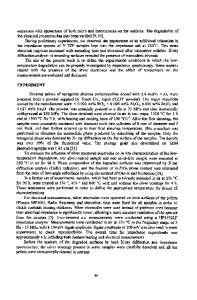Stability of monoclinic and tetragonal zirconia at low oxygen partial pressure
- PDF / 107,970 Bytes
- 5 Pages / 612 x 792 pts (letter) Page_size
- 59 Downloads / 305 Views
MATERIALS RESEARCH
Welcome
Comments
Help
Stability of monoclinic and tetragonal zirconia at low oxygen partial pressure Niels Mommer, Theresa Lee, and John A. Gardner Department of Physics, Oregon State University, Corvallis, Oregon 97331 (Received 23 September 1999; accepted 29 November 1999)
We have found that both tetragonal and monoclinic zirconia annealed at temperatures in the range of 1100 to 1300 °C in atmospheres of low oxygen partial pressures (down to 10−26 Pa) transform slowly to an apparently cubic phase. The transformation can be reversed by increasing the oxygen partial pressure sufficiently, i.e., exposing the sample to air again. These observations were made by 111In/Cd perturbed angular correlation (PAC) measurements of undoped zirconia samples. Upon annealing under various reducing atmospheres PAC spectra show a steadily increasing fraction of Cd probe atoms in a locally cubic environment with the fraction of probe atoms in tetragonal or monoclinic sites decreasing accordingly.
I. INTRODUCTION
Partially stabilized tetragonal and fully stabilized cubic zirconia are important materials in ceramic engineering with numerous applications.1,2 Thus knowledge of the crystal structures of the zirconia polymorphs and of the transition mechanisms between them are of considerable interest in view of their connection with the properties of advanced zirconia based ceramics. At atmospheric pressure, ZrO2 displays three polymorphs. At low temperatures the monoclinic phase is stable. 3 Around 1170 °C there is a martensitic phase transition to a tetragonal structure.4 At a temperature of about 2380 °C, the tetragonal phase transforms into the cubic structure.5 At high pressures, a variety of phase transitions have been observed but there is as yet no general agreement about the pressure dependent phase diagram. Preliminary results6 give two phases with orthorhombic symmetry, an orthorhombic phase closely related to the monoclinic phase and one with a distorted cotunnite (PbCl2) structure. A more recent study7 proposes the persistence of the orthorhombic phases up to about 50 GPa but does not confirm the space group previously reported. Phase diagrams of the Zr–O system show that under reducing conditions the cubic phase can coexist with the tetragonal phase down to temperatures of about 1500 °C,8–11 where an eutectoid is reported at a composition of about ZrO1.75. At lower oxygen contents Zr(␣) metal is suggested to coexist with cubic oxygen deficient ZrO2−x , at higher oxygen contents cubic ZrO2−x with tetragonal ZrO2−x. We have investigated the behavior of ZrO2 at low oxygen partial pressures using perturbed angular correlation spectroscopy (PAC) to determine the symmetry of the electric field gradient (EFG) and thereby the symmeJ. Mater. Res., Vol. 15, No. 2, Feb 2000
http://journals.cambridge.org
Downloaded: 12 Mar 2015
try of the structure (i.e. monoclinic, tetragonal or cubic). While PAC does not give the full structure in detail, as does x-ray diffraction (XRD), it reveals the symmetry of the elec
Data Loading...











